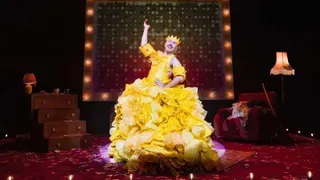December 10, 2010
New Orleans Museum of Art Celebrates First Century
Robert Doyle READ TIME: 3 MIN.
NEW ORLEANS (AP) - When the New Orleans Museum of Art opened its doors 100 years ago thanks to a $150,000 donation offered by a local businessman to build a "temple of art for rich and poor alike," it owned only 11 pictures and a small collection of other objects.
Now, thanks to the donations of others over the years, NOMA has more than 35,000 pieces in its permanent collection - ranging from Degas, Picasso, Chagall and other big-name artists, to dramatic African and Asian art, antique glass and a sculpture garden featuring works by 20th century greats such as Henry Moore and Louise Bourgeois.
"They have a really amazing collection for which they don't get enough recognition," said Arnold Lehman, director of the Brooklyn Museum. "Other than Texas, which has those amazing museums, it has the most important collections in the whole six or seven states in the southern area."
The present collections, valued at over $500 million, fill a museum that is more than 13 times as large as the original.
"It's great to have a world-class museum in our region," said George D. Bassi, president of the Southeastern Museums Conference. "And when you look at art museums in the southeast region, NOMA is one that comes to mind, not only in collection but in its exhibitions and educational programs."
To celebrate its centennial, the museum is staging a show of those collections and the people who made them possible - "Great Collectors/Great Donors: The Making of the New Orleans Museum of Art, 1910-2010," which runs through Jan. 23.
The show highlights various decades in the museum's growth and the wealthy patrons who built collections including Japanese painting, Indian tribal art, traditional African carving and the five-acre Sydney and Walda Besthoff Sculpture Garden.
"Certainly the gifts that make up the sculpture garden have been some of the greatest in our history," said former director John Bullard, who retired in September after 37 years with the museum.
NOMA's funding sources include some money from the city, endowment earnings, income from the shops, ticket sales, and memberships as well as donations and fundraisers, but none of it would be enough to build the museum's collections without major benefactors.
"They have some of greatest collections, certainly in the south, but also some that rank right up there nationally," said Bonnie Pittman, director of the Dallas Museum of Art.
Bullard said selections for the show were difficult to make. He whittled it down to collections from nearly 30 patrons including primitive paintings, delicate Japanese art, Indian brass, silver dinnerware, photography and antique glass. The works were chosen to show the collector's vision, passion for obtaining each item, and interest in making it available to the public.
"A collector collects because that's what he does," said Dr. Siddharth Bhansili, a cardiologist who has helped NOMA build its collection of Indian art. "You want to possess something, but when it's in my possession I invariably ask where I would want to see this - in my home, in my warehouse or in the museum."
___
If You Go...
NEW ORLEANS MUSEUM OF ART: One Collins C. Diboll Circle, City Park, New Orleans; http://www.noma.org/ or 504-658-4100. Open Wednesdays noon-8 p.m.; Thursday-Sunday, 10 a.m.-5 p.m. Adults, $10; children 3-17, $5; Louisiana residents, $8. "Great Collectors/Great Donors: The Making of the New Orleans Museum of Art, 1910-2010," runs through Jan. 23.
Long-term New Yorkers, Mark and Robert have also lived in San Francisco, Boston, Provincetown, D.C., Miami Beach and the south of France. The recipient of fellowships at MacDowell, Yaddo, and Blue Mountain Center, Mark is a PhD in American history and literature, as well as the author of the novels Wolfchild and My Hawaiian Penthouse. Robert is the producer of the documentary We Are All Children of God. Their work has appeared in numerous publications, as well as at : www.mrny.com.




